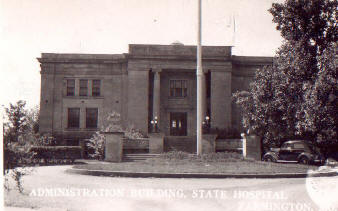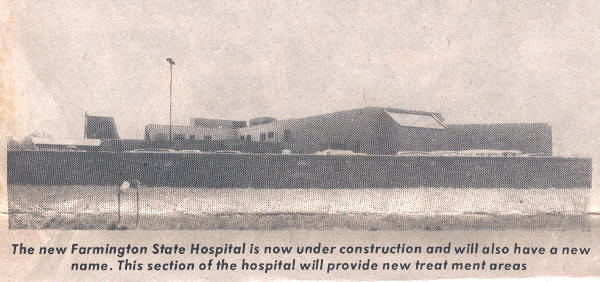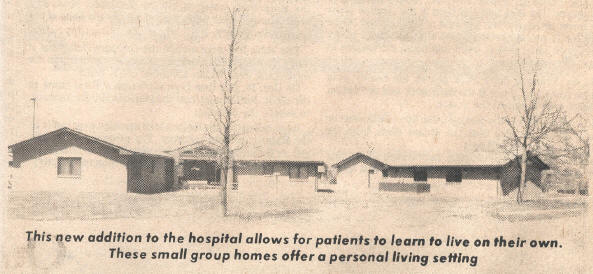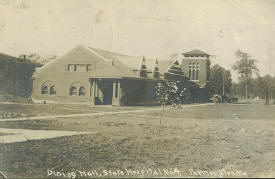 |
REFLECTIONS ON
FARMINGTON STATE HOSPITAL
|
 |
REFLECTIONS ON
FARMINGTON STATE HOSPITAL
|
Since the first seven patients were admitted to Farmington State Hospital in 1903, there has been one constant: Expect changes.
Through the years, popular opinion and legislative action have been responsible for changes in everything from treatment methods to the hospital's conversion to a medium security prison for 2,000 inmates.
The conversion has not been an easy one, said superintendent Fred McDaniel.
"I have somewhat mixed emotions because it has been a big headache for me," he
said. "But I am looking forward to moving into a new building. We're probably
over the worst part. At least we know where we're going."
 |
Despite the inconvenience -- "the worst part was getting from here to there" -- McDaniel doesn't foresee any problems once the move is complete.
Said Don Barton, director of treatment services, "When it first occurred, like most people, I was a little fearful. In the final months, though, I think I'm excited. It's going to be good for us. It means we can start over."
The patients are also feeling the effects, said Paula Lee, director of nursing. "They're very concerned," she said. "It's like losing their home. And many are asking, 'Who's going to take care of me?'"
Under the conversion plan, in 1984, a new hospital will be constructed and the group homes, Doctor and Blair Buildings, doctors' housing, dairy barn and superintendent's house, which will be converted into an outpatient center, will remain under its control. An inmates' treatment center will be located in the Hall and Drum Buildings.
A number of factors led to the conversion. First, converting the hospital was called the "cheapest and most expeditious" option available to ease overcrowding in the state's prisons.
The shift toward community-based treatment, as opposed to long-term care facilities, also influenced the decision, as did cutbacks in funding to the state's mental health facilities.
These factors converged in a 1982 Mental Health Commission report
recommending the closing of Farmington State Hospital. The commission reasoned
that the St. Louis facility could accommodate patients transferred from the
Farmington site. Building the smaller hospital now under construction, it was
also concluded, would provide needed acute psychiatric care in Southeast
Missouri.
 |
When the conversion is complete and the staff and patients move into the new
facilities now under construction, 320 patients will be housed at the hospital,
and the treatment center, to be located behind the prison fence, will hold 200
patients assigned from the state's corrections system.
 |
A population of 320 is a big change for a hospital accustomed to housing as many as 2,000 patients. Despite staff members' efforts, crowded conditions in state hospitals can force what one official called "warehousing people." Fewer patients, pointed out Mrs. Lee, nursing director, means better treatment and shorter stays. "Today, you see people that are treated, improved and discharged," she said.
Hospital officials credit most of these shifts as changes for the better. The most important change, they agree, has been the steady decline in patient population. In 1960, Farmington State Hospital housed 1,989 patients, an all-time high. Today, approximately 300 patients live on the grounds. Community treatment centers throughout the hospital's service area oversee the treatment of those fit for outpatient care.
Don Barton joined the hospital staff in 1963, "fresh out of graduate school."
He recalls, "My first reaction was that we had a lot of patients -- 1800? -- and very little professional staff."
Cutting the population, through improved drugs and treatment methods, was a major benefit to the patients and staff, Barton said. "We were able to reduce the population down to a level that allows treatment to take place. If you had 1,800 patients, you were lucky if you could just provide the basic requirements of housing and shelter."
Changes in the public's attitude toward the hospital also helped, he said. "The public said, 'We want treatment,' and that theme was picked up by the courts." In time, the General Assembly followed through with funding. Improving patient care has been the hospital's main concern since its inception. In 1899, the Missouri General Assembly began the search for a site and eventually purchased 326 acres at the hospital's present site. The state contributed $13,889 and the taxpayers paid $6,100 for the land.
The state budgeted $150,000 to build the hospital itself and in 1901, an additional $120,000 went for new buildings and equipment.
Five cottages were built for patients and from 1901 to 1902 a dining room, kitchen, power house, barns, laundry, ice plant, the folk building (set aside for nurses, attendants and recreation), an administration building, the Hall building, the superintendents' residences and the Harrison Building, a receiving building and acute care hospital, were constructed.
 |
|
Dr. William Hall admitted the first three patients in 1903 and by 1904, the population stood at 332. By 1907, 795 patients were housed at the hospital. By 1922, the hospital was so crowded the superintendent's home was converted to housing for women patients.
In 1925, the Hyde Building was built and the Folk Building was converted to house female patients.
Another milestone was marked in 1925 when Dr. Emmett Hoctor took over as superintendent of Farmington State Hospital, then known as State hospital Number 4.
|
Hoctor's tenure, which lasted until 1978, marked a remarkable period of change in the hospital. New facilities were built, existing facilities improved and a number of innovations in psychiatric treatment implemented.
In 1931, the diathermy machine was introduced to treat paresis, a form of paralysis. Before, physicians had induced a high fever in paretic patients by injecting them with malaria germs. While the malarial fever did help some patients, the danger of dying of malaria outweighed the benefits.
When penicillin was discovered, it replaced the diathermy machine, chiefly because it was dramatically effective for treating syphillis, the major cause of paresis.
In 1932, the hospital established its first community-based treatment center when it set up a clinic for mental health education and consultation in the New Madrid County Courthouse. Other clinics were set up in Mississippi and Scott Counties and today clinics can be found in Sikeston, Cape Girardeau, Kennett and West Plains.
On June 6, 1940, Dr. Paul Schrader performed the first lobotomy. In the first months of 1940, 64 major lobotomies were performed at the hospital. All told, 200 lobotomies were performed at the hospital, the last in 1943.
Electroshock therapy was introduced in 1942.
During the 1930s and '40s, several WPA projects were completed on the hospital grounds, including utility tunnels, storm sewers and a new dairy barn.
The 1950s and '60s were a period of overcrowding for the hospital. In 1954, the average daily patient population was 1,879. The recommended capacity was 1,600.
By 1970, the hospital was serving 25 counties and the Alcoholism Treatment Center had been expanded to handle drug abuse patients. Treatments in practice included recreation, music and occupational therapy.
In 1972, the Blair Building, the last of the new buildings, was opened as a psychiatric medical facility.
 |
By 1975, the average daily population had fallen to 521 patients at the state hospital, but an average of 600 people were treated monthly on an outpatient basis.
In 1978, Dr. Hoctor retired after a 53-year career with Farmington State Hospital, and the institution marked its 75th anniversary.
By 1982, the population had fallen to 320 on the hospital grounds, the level stipulated under the conversion plan.
The information on this site is provided free for the purpose of researching your genealogy. This material may be freely used by non-commercial entities, for your own research. The information contained in this site may not be copied to any other site without written "snail-mail" permission. If you wish to have a copy of a donor's material, you must have their permission. All information found on these pages is under copyright of Oklahoma Cemeteries. This is to protect any and all information donated. The original submitter or source of the information will retain their copyright. Unless otherwise stated, any donated material is given to MOGenWeb to make it available online.